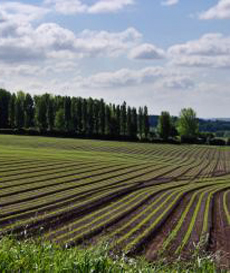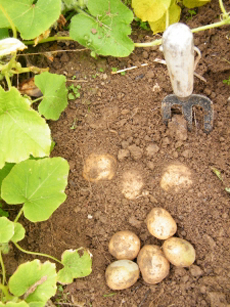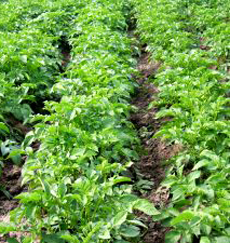
A neatly manicured potato field. Photo by Jim Daly | SXC.
|
MALLIKA RAO is an intern at THE NIBBLE. |
|
November 2010
Last Updated September 2018 |
 |
Potato Cultivation
Page 2: Potato Cultivation
This is Page 2 of a seven-page article, including a Potato Glossary. Here, an overview of potato cultivation. Click on the black links below to view other pages.
| Article Index: |
Potato Glossary: |
|
|
Potato Cultivation
A potato is an underground part of the plant stem that has thickened, and is called a tuber. This tuber is the only part of the plant that is eaten.
Potatoes are 80% water, and require a reasonable amount of it for growth. They are planted using seed potatoes, which are grown specifically for reproduction. Each seed potato has 1 to two 2 eyes.
Leaves grow above ground and roots underground. As the potato grows, starch is transferred to the ends of the underground stems.
The roots absorb nutrients and the leaves absorb sunlight, which converts to energy for growth.
The “eye” of a potato forms the bud of new shoots.
Store potatoes in a cool, dark and dry location to avoid this shoot growth in harvested potatoes. If your potatoes sprout, be sure to cut these shoots before eating. |
|

Potatoes grow just under the surface of the soil. Photo by Christa Richert | SXC. |
When Potatoes Are Toxic
Remember those Europeans who wouldn’t eat the first potatoes that arrived, believing them to be poisonous? They were correct, to a point.
Nightshades contain a bitter toxin called solanine, but it’s only in the leaves and stems, not in the roots and tubers.
That’s why the tasty-looking stems and leaves of the potato are discarded after harvest. As mentioned above, sprouts from the eyes of a harvested potato are also poisonous.
The culprit is a glycoalkaloid, a member of a family of poisons commonly found in the nightshade family (Solanaceae). The particular glycoalkaloid, solanine, is also found in the leaves of tomatoes. It’s purpose is as a natural defense mechanism to protect the plant from predators. |
|

The leafy tops of potato plants look like attractive greens, but are toxic. Photo by Nick Ballesteros | SXC. |
However, sweet potato leaves are edible, and are popular sautéed and in stir-fries. That’s because sweet potatoes (Ipomoea batatas) are from an entirely different botanical family, Convolvulaceae (the “morning glory” family). They’re not nightshades like the potato (Solanum tuberosum, family Solanaceae).
Continue To Page 3: How To Buy & Store Potatoes
Go To The Article Index Above
Content
|






